Indian cities are currently witnessing a trend of growing private ownership (cars and two-wheelers) of vehicles and declining public and non-motorised transport use. As per the Road Transport Year Book, 230 million vehicles are plying on Indian roads in 2016 out of which 86% of vehicle share is of the private vehicles[1].
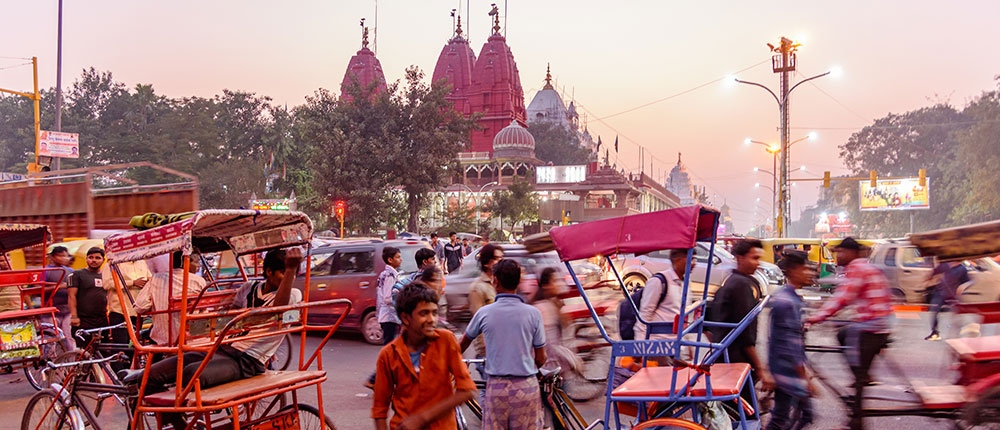
These trends have implications on India's energy consumption, energy security, pollution, congestion, health and safety. As per TERI, the transport sector is highly dependent on oil imports and accounts for about 24% of commercial energy consumption in the country. Another implication of increased private vehicle ownership is the increased demand for parking space. According to Institute for Transportation and Development (ITDP), cars and two-wheelers have the highest share of street space, yet they serve less than a third of all trips and are idle for 95 per cent of the time—consuming parking. Clearly, there is a need to maximise the utilisation of the existing assets (vehicles) in the transportation sector. By increasing the occupancy of passenger vehicles, India has the potential to reduce vehicle kilometre demand by nearly 35%, accounting to 2000 billion kilometres in 2035 (RMI). According to the NITI Aayog, any mode of transportation that is shared by users on an as-needed basis, from bikes to 4-wheelers to mass transit can constitute shared mobility. This includes a vast list of mobility options from sharing your car with your neighbour to hailing a cab to taking the bus or the metro is shared mobility. Certainly, all these modes are not equally best for the future of sustainable mobility in India. Here, we attempt to clear the haze on the various shared mobility options by classifying them according to what is being shared and what they offer.
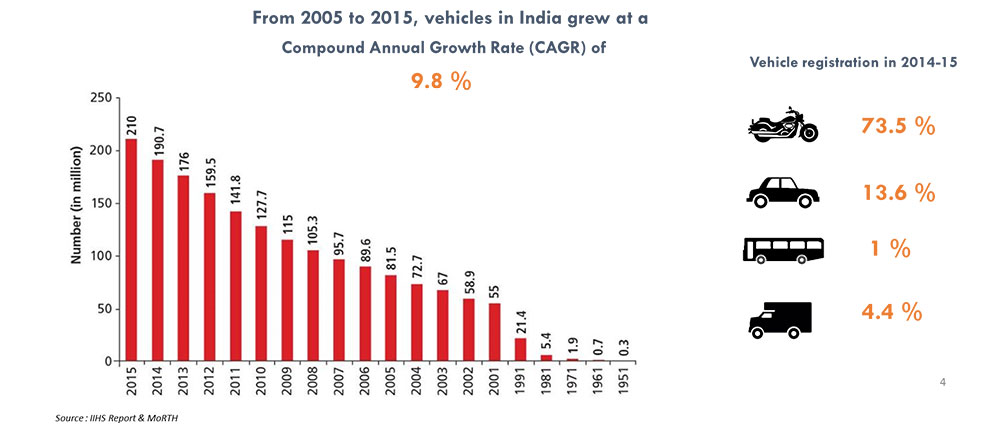
We can divide the shared mobility into two categories
- Sharing of Transportation Resources and/or
- Sharing of Transportation Services
The sharing of resources increases the vehicle utilisation and the sharing of services reduces the emission per passenger kilometres.
A) Sharing of Transportation Resources or vehicles includes the popular public bike-sharing where the transportation resource (vehicle) is rented to a user for a period of time. This largely has B2C (Business to Consumer) models operating in India due to legal and operational barriers in peer-to-peer bike/scooter/motorbike sharing.
Similar to bike sharing, car sharing in India is also largely operated under B2C models. Zoom Car is an example where the user can rent a car for personal use. There are C2C (peer to peer) car-sharing models in Europe, like Drivy in the UK, which is a mobile application facilitating peer-to-peer car sharing. There are also co-operative car-sharing models in Canada, where large groups own and share a limited number of cars.
Scooter/Bike Sharing (Mostly B2C)
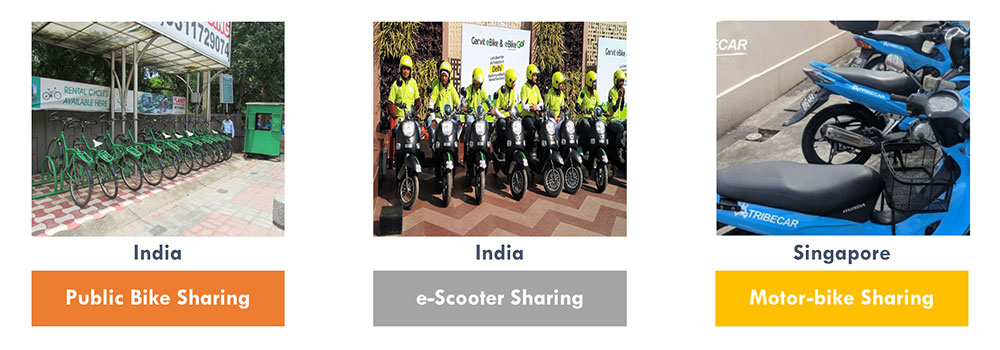
Car Sharing
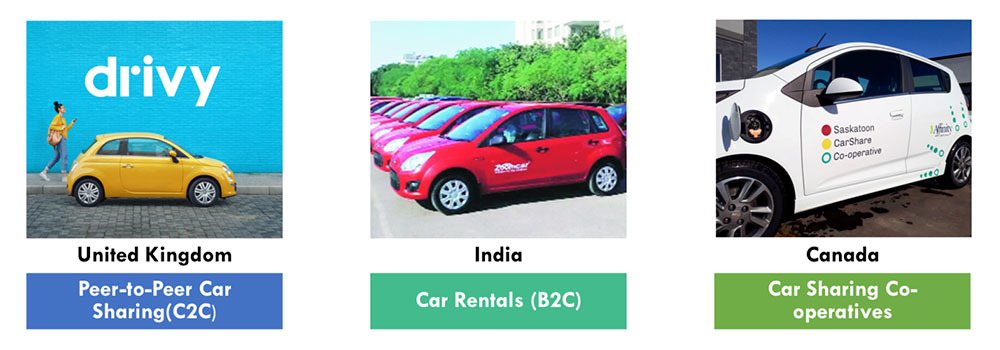
B) Sharing of Transportation Services may be classified as ride-sharing on fixed routes or ride-hailing and sharing in flexible route.
Ride Sharing includes services like carpooling (BlaBla Car App), Micro-Transit or Shuttle Services (Shuttl App), the traditional ride-sharing of IPT in India (auto-rickshaw sharing) and Public Transport. The routes in such models are fixed and there is limited last-mile connectivity.
Ride Hailing and Sharing means the passenger will summon the vehicle to his location and will share the ride with other passengers on a similar route. This is mainly offered in India by Transportation Network Companies as a feature along with regular rides (Uber Pool, Ola Share). This provides last-mile connectivity to all sharing riders but there is large uncertainty regarding transit time.
Ride Sharing
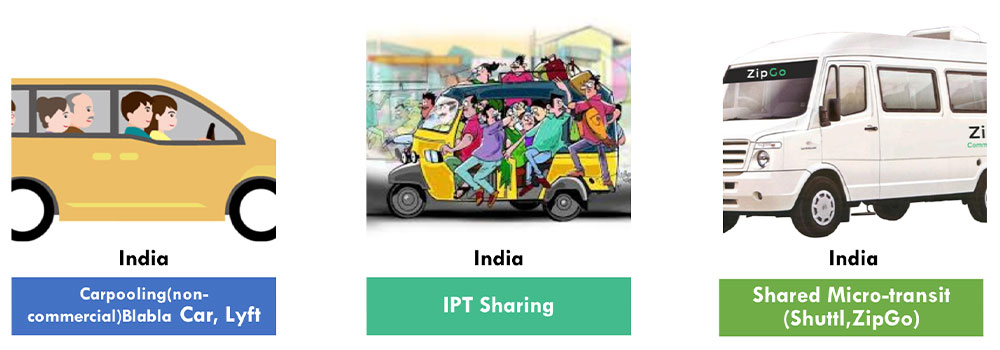
Ride Hailing & Sharing (Flexible Routes)
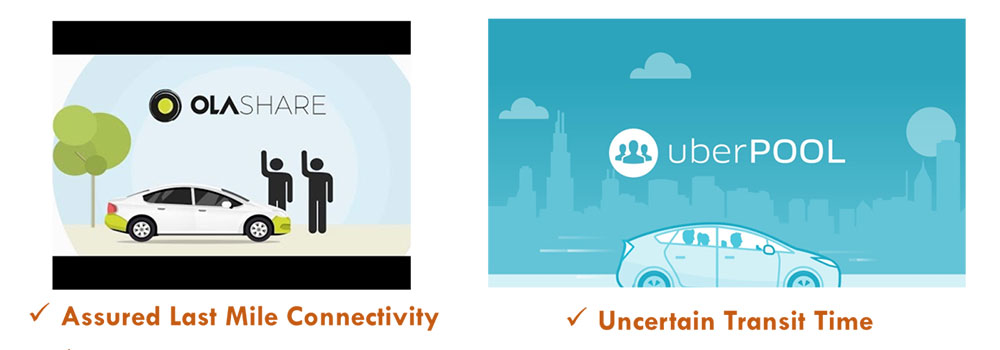
The following table summarises the shared mobility solutions present in the current global transportation scenario.
Table 1: Shared Mobility Solutions
| Sharing Type (Vehicle or Ride) | Shared Mobility Type | Business Type | Example |
| Vehicle | Bicycle Sharing | B2C | India- Delhi |
| Vehicle | e-Bike Sharing | B2C | India- Mobicy |
| Vehicle | Bike/Scooter Sharing | B2C | India- Goa |
| Vehicle | Peer to peer car | C2C | United Kingdom- DRIVY |
| Vehicle | Car rentals | B2C | India- Zoom car |
| Vehicle | Car sharing co- operatives | Co-operative ownership | Canada- University of saskatchewan |
| Ride | Ride Sharing (Fixed Routes | C2C | Carpooling (non-commercial) Blabla Car, Lyft |
| Ride | Ride Sharing (Fixed Routes | B2C | Three-wheeler sharing |
| Ride | Ride Sharing (Fixed Routes | B2C | Shared Micro-transit (Shuttl,ZipGo) |
| Ride | Ride Hailing & Sharing (Flexible Routes) | B2C | India - OLA pool, Uber share |
| Vehicle* | Ride Hailing | B2C | India- OLA, Uber |
*Why Transportation Network Companies in India operate differently?
Transportation Network Companies initially came with the purpose of boosting the shared economy in mobility by linking private vehicle owners and potential drivers to potential riders and hence utilising the unused private vehicles on road. However, in India, Transportation Network Companies cars are driven by full time drivers and these vehicles need permits and are bought and registered primarily for the purpose of operations as a taxi. Hence, the services from Transportation Network Companies like Ola and Uber in India are as good a shared mobility mode as are regular taxis. Whereas, in Europe or Australia, other than serving as a taxi, these companies also facilitate the utilisation of existing private cars.
All of the examples of shared mobility discussed above are contributing to improved utilisation of vehicles and/or reduced emissions per passenger kilometre. However, their effect of the same is varied. For example, the B2C Vehicle sharing model like Zoom car will definitely keep a check on car ownership and the parking congestion, but it has no effect on the emissions per passenger kilometre and the on-road congestion. On the contrary, a similar B2C bike-sharing discourages ownership of two-wheelers, reduces parking congestion and reduces the emission per passenger kilometre to zero.
Compare a situation where everyone uses ride-sharing services of Transportation Network Companies with a situation where the ride-sharing Micro transit solution is coupled with last-mile ride sharing solution like bike-sharing. Which do you think is a sustainable solution for the city? Now consider a situation where we compare the later solution from above with a Public Transport system like metro or bus coupled with bike-sharing.
In the following table, we have assessed shared mobility solutions based on the emissions, congestion and parking requirements.
Table 2: Sustainability Assessment of Shared Mobility Solutions
| Taxi Share | Shared Micro transit with bike sharing | PT[2] with bike Sharing | PT with shared e-rickshaw | |
| Emissions per passenger kilometer (First & Last Mile Connectivity) | High | Low | Low | Low |
| Emissions per passenger kilometer (Main Journey) | High | Low | Lower | Lower |
| On Road Congestion | High | Low | Lower | Lower |
| Last Mile Congestion | High | Low | Low | Lower |
| Parking Congestion | Low | Low | Low | Low |
Through the comparative assessment above, we are attempting to highlight that different shared mobility solutions have varied impact on congestion and pollution. Hence, incentivising of shared mobility solutions must be a carefully planned process so that the solutions adopted are sustainable in providing efficient mobility to the urban commuters with minimal pollution. One possible way to incentivise the "right" shared mobility solutions would be to promote High Occupancy in all passenger vehicles. The lens of High Occupancy for promoting shared mobility will filter out the most sustainable solutions out of the many mobility solutions available today.
Despite defining various shared services, their carriage system remains unclear in the Indian policy scenario. Though the National Urban Transport policy promotes shared services and various states have already come up with notifications for taxi aggregators, some regulatory questions remain unanswered.
- Should the shared services in contract and stage carriage be limited by permits or be driven by the market?
- Should there be a minimum percentage of occupancy for modes to be classified as shared mobility?
- Should the fares of shared mobility be regulated or market-driven?
- How do we promote and incentivise efficient, clean and safe form of shared mobility?
Footnotes
[1] https://morth.nic.in/sites/default/files/other_files/Road_Transport_Year_Book_2015_16.pdf
[2] PT could be any public transport mode including metro, bus, Bus Rapid Transit etc.
